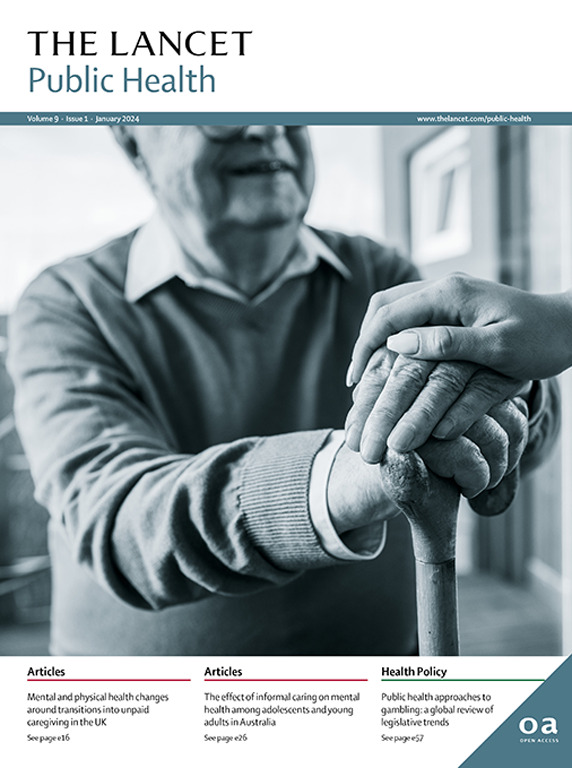Long-term mental health trajectories across multiple exposures to climate disasters in Australia: a population-based cohort study
IF 25.4
1区 医学
Q1 PUBLIC, ENVIRONMENTAL & OCCUPATIONAL HEALTH
引用次数: 0
Abstract
Background
Tracking populations through increasingly frequent climate disasters and understanding what contributes to mental health risks is crucial for adaption and planning for a climate changed world. We aimed to examine mental health trajectories after consecutive climate-related disasters and assess differences in mental health outcomes by temporal proximity to previous disasters and risk profiles.Methods
Using longitudinal population-based Australian data from 2009 to 2019, people who experienced home damage from at least one disaster (flood, bushfire, or cyclone) were included in the exposure population and tracked from pre-disaster to post-disaster years after each exposure. Cumulative mental health effects of each sequential exposure were estimated through various mental health measures using a panel event study design with linear models in comparison to unexposed matched controls, pre-disaster baselines, and across stratified risk groups. The main mental health outcome was measured with the 5-item mental health inventory (MHI-5).Findings
Mental health effects became more severe with successive disasters. MHI-5 scores declined by 1·61 (95% CI –2·69 to –0·52) and 3·37 (–6·45 to –0·29) during the first and repeat disaster exposures, respectively, compared with the year preceding the first disaster. Recovery to a pre-disaster baseline was more delayed with repeat disaster exposures. There were greater declines in mental health when disasters were closer to the previous exposure (1–2 years apart) than further away (3 or more years). Risk factors that shape mental health trajectories either remained consistent across multiple exposures (social support as protective and long-term health conditions as risks) or became more salient during subsequent exposures (lower household income and rural areas more vulnerable to the mental health effects of repeat disasters).Interpretation
Additional disaster exposures were associated with greater declines in mental health and shifts in some risk factors. Multiple disaster exposures must be urgently considered in public health, welfare, and disaster services.Funding
Australian Research Council.澳大利亚多次暴露于气候灾害中的长期心理健康轨迹:一项基于人口的队列研究
背景:通过日益频繁的气候灾害跟踪人口,了解导致心理健康风险的因素,对于适应和规划气候变化的世界至关重要。我们的目的是检查连续气候相关灾害后的心理健康轨迹,并通过与先前灾害和风险概况的时间接近来评估心理健康结果的差异。方法利用2009年至2019年澳大利亚基于人口的纵向数据,将至少经历过一次灾害(洪水、森林大火或飓风)造成的家庭破坏的人纳入暴露人群,并在每次暴露后从灾前到灾后进行追踪。每个连续暴露的累积心理健康影响是通过各种心理健康测量来估计的,使用线性模型的小组事件研究设计,与未暴露的匹配对照、灾前基线和跨分层风险群体进行比较。主要心理健康结果采用5项心理健康量表(MHI-5)进行测量。随着灾难的不断发生,心理健康受到的影响越来越严重。与第一次灾害发生前相比,第一次和第二次灾害发生时,MHI-5得分分别下降了1.61分(95% CI为- 2.69 ~ - 0.52)和3.37分(- 6.45 ~ - 0.29)。随着灾难的重复暴露,恢复到灾前基线的时间会延迟。当灾难发生的时间距离前一次暴露的时间更近(间隔1-2年)时,心理健康状况的下降幅度大于灾难发生的时间(间隔3年或更长)。影响心理健康轨迹的风险因素,要么在多次接触中保持一致(社会支持作为保护性条件,长期健康条件作为风险),要么在随后的接触中变得更加突出(家庭收入较低,农村地区更容易受到重复灾害的心理健康影响)。额外的灾害暴露与心理健康的更大下降和一些风险因素的变化有关。公共卫生、福利和灾害服务必须紧急考虑多重灾害风险。资助澳大利亚研究委员会。
本文章由计算机程序翻译,如有差异,请以英文原文为准。
求助全文
约1分钟内获得全文
求助全文
来源期刊

Lancet Public Health
Medicine-Public Health, Environmental and Occupational Health
CiteScore
55.60
自引率
0.80%
发文量
305
审稿时长
8 weeks
期刊介绍:
The Lancet Public Health is committed to tackling the most pressing issues across all aspects of public health. We have a strong commitment to using science to improve health equity and social justice. In line with the values and vision of The Lancet, we take a broad and inclusive approach to public health and are interested in interdisciplinary research.
We publish a range of content types that can advance public health policies and outcomes. These include Articles, Review, Comment, and Correspondence. Learn more about the types of papers we publish.
 求助内容:
求助内容: 应助结果提醒方式:
应助结果提醒方式:


